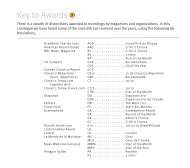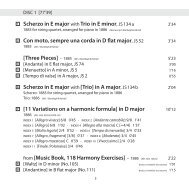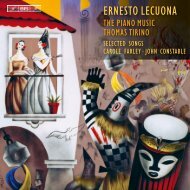MENDELSSOHN - Bis
MENDELSSOHN - Bis
MENDELSSOHN - Bis
You also want an ePaper? Increase the reach of your titles
YUMPU automatically turns print PDFs into web optimized ePapers that Google loves.
per formed in the Thomaskirche in Leipzig (Johann Sebastian Bach’s former place<br />
of work) on the evening of 25th June 1840, was assembled by the composer<br />
himself. With the exception of the chorale text ‘Nun danket alle Gott’ (‘Now<br />
thank we all our God’) and some passages from St Paul’s Epistles, all of them<br />
come from the Old Testa ment.<br />
The Hymn of Praise was originally planned as a ‘smaller oratorio or larger<br />
hymn’ (letter to Klinge mann, 16th February 1840), then as a ‘symphony for choir<br />
and orchestra’ (letter to Klinge mann, 21st July 1840), and finally – according to<br />
the title page of the published edition – as a ‘symphony-cantata after words from<br />
the Holy Bible’. The work has many parallels with the purely instrumental ‘Re -<br />
forma tion’ Sym phony, composed ten years previously ‘to celebrate the church<br />
revolution’ (i.e. to mark the 300th anniversary of the Augsburg Confession of<br />
1530). In that work, which remained unpublished during Mendelssohn’s lifetime,<br />
the composer used sev er al religious songs, and as the last movement wrote sym -<br />
phonic variations on Luther’s chorale ‘Ein feste Burg ist unser Gott’ (‘A mighty<br />
fortress is our God’). In a sense the Hymn of Praise is a continuation of the ‘Re -<br />
forma tion’ Sym phony with other means – a symphony with (this time a genuine,<br />
vocal) sung finale.<br />
The Hymn of Praise consists of two main sections. The first, entitled ‘Sin fo -<br />
nia’, consists of three instrumental symphonic movements, which are played with -<br />
out inter ruption – an innovation in symphonic music. The second is a cantata<br />
com pris ing nine movements (Nos 2–10). The principle of having a symphony<br />
that cul minates in and ends with a vocal section has inevitably given rise to com -<br />
parisons with Beetho ven’s Ninth Symphony – comparisons that have usually not<br />
been to Men delssohn’s ad van tage. As demonstrated by the rela tion ship with the<br />
‘Reformation’ Symphony, however, Mendelssohn was further developing a wholly<br />
independent project which, especially in its cyclical interweaving of the instru -<br />
23








